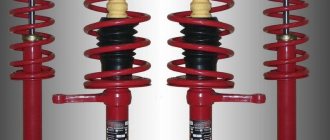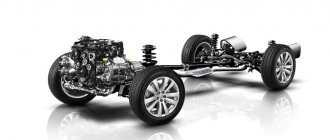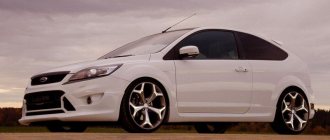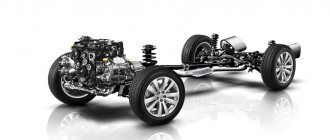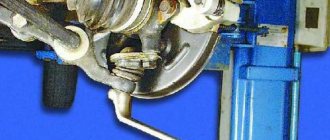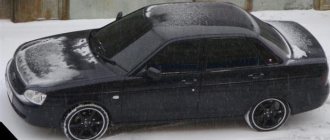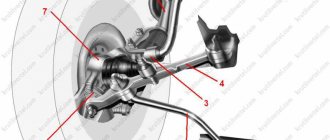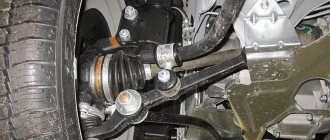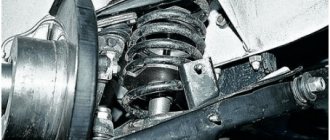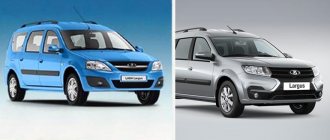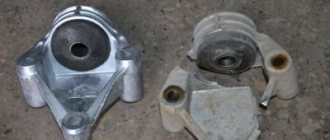Shock absorber struts
This is the main element of the suspension, since it is with their help that vibrations are damped while driving on uneven roads. The struts on the Kalina consist of a metal body in which a telescopic shock absorber is located. The system is hydraulic and works in both directions. When repairing the Lada Kalina, special attention must be paid to the condition of the suspension elements. Not only comfort, but also safety depends on it.
Between the strut and the body there is a coil spring and an upper support bearing. A bracket is welded to the body on the rack, with which the steering knuckle is attached. Approximately near the middle of the rack there is a swing arm that connects to the steering end. A little higher is the lower cup, into which the spring rests.
How to check support bearings on Kalina
Before replacing the support bearings on the Lada Kalina, you should make a diagnosis and make sure that the “support” has failed , so check out the signs of failure:
- Clicks, knocks of Kalina’s “supports” (audible under the hood, when the shock absorbers are operating);
- A cracking sound is heard from the front side under the hood (when turning);
- Handling deteriorates, play at the steering wheel increases;
- You can feel the bumps in the road through the steering wheel.
If such signs are present, then there is a 99% chance that replacing the support bearing of the Kalina front strut is inevitable, but first make a diagnosis. 1. Place the car on a flat surface and open the hood. 2. Find the upper support, press this place with your palm. 3. Rock the car from bottom to top so that the Kalina front strut supports and shock absorbers work. 4. If you feel or hear knocking noises, it means it's time to replace the support bearing. 5. Ask an assistant to rotate the steering wheel and listen to how the unit works; when in good condition, the “support” functions silently.
Front pillar elements
On the Lada Kalina car, the struts can be equipped with conical or barrel springs. It all depends on what equipment the car has. The lower coil of the spring rests against the support cup, which is tightly welded to the rack. The upper coil rests on the cup, which is attached to the shock absorber rod.
The rod is secured to the upper support bearing, which, in turn, is screwed to the body using three studs. Thanks to the bearing, the shock absorber rod rotates inside the support. This allows the wheels of the car to turn. A boot must be installed on the shock absorber rod, which protects the inner surface of the element from contamination.
Gearbox lever rattling
For LADA Kalina, a typical malfunction is rattling in the area of the gearshift lever, which mainly becomes noticeable when the engine is running at speeds of about 3000. The source of the side sound is the bushing, which is made a little thicker than necessary, and because of this, a gap appears in the mount. To resolve this problem you need to do the following:
- remove the handle cover, which is attached with latches;
- using two 13mm wrenches, unscrew the nut and bolt;
- remove washers and bushings;
- to eliminate rattling, the bushing in the middle needs to be slightly sharpened in width or the mount should be lubricated with sealant;
- Having done this, mount everything back. The sealant does not help out every time, but if you sharpen the bushing by 0.3 mm, the result is guaranteed.
It’s safe to say that repairing a Lada Kalina car yourself is not so scary. Every car enthusiast has the opportunity to eliminate minor malfunctions of this car. You just need to believe in yourself, follow our advice and everything will work out!
- Seven tuning
- Tuning VAZ 2108
Rotary mechanisms
When repairing the Lada Kalina, it is necessary to take into account the fact that after intervention in the design of the front suspension, it will be necessary to adjust the camber and toe of the wheels. A swing arm is installed on the shock absorber strut. Moreover, on two identical racks its position will be different. This lever has a hole into which the tie rod end is installed. Its length can be changed using a specially designed coupling.
The steering knuckle is secured to the front strut bracket using two bolts and nuts. The upper bolt has an oval washer, with which the camber of the wheels is adjusted. By rotating the bolt, you move the steering knuckle relative to the front strut. At the bottom it is secured by a ball joint to the wishbone of the suspension.
AST SUSPENSION
The Dutch company AST Suspension has been designing and producing suspension components and kits for 35 years; The range has different lines - for ordinary roads and for sports. In Russia, the sale of its products is carried out by the company, which is headed by former rally driver Alexey Kovalchuk. It’s nice that the Dutch are upgrading their kits taking into account operating experience in our conditions.
It was possible to choose the extreme 5200 model - with remote reservoirs and various adjustments, but, firstly, such a design is not allowed by the RHHCC regulations, and secondly, the price of such a kit is a third of the cost of Kalina. Non-professional athletes have no use for this.
Suspension arms
The Kalina front suspension arm is kept from moving by a stretcher. This extension is secured at the rear edge to the lever with rubber-metal hinges. The front edge of this stretch is secured with a cushion to a special bracket, which is screwed to the car body. You can change the number of washers that are located in the rear and front mounts of this extension. This way you can adjust the angle of inclination of the wheel axis in the longitudinal direction.
The stabilizer is connected to the front suspension arms. Its middle part is secured with brackets and rubber pads on the body. When one lever moves, movement is transmitted through the stabilizer to the second. This can significantly reduce the swaying of the car when driving on uneven roads, as well as reduce roll when cornering.
The new Lada Kalina practically does not need to be serviced; it is only advisable to occasionally check the alignment angles of the front wheels. It is also recommended to carry out suspension diagnostics from time to time in order to identify breakdowns in the early stages.
Causes of breakdowns, as well as ways to eliminate them
It doesn’t matter what configuration the car is, be it a sedan or a hatchback, each of them needs regular inspections during operation. However, few car owners know about this. There is an opinion that during operation a car only needs a technical inspection, but this is not the case.
If you carry out regular inspections and identify breakdowns in the early stages, you can save yourself a lot of work and costs in the future.
Repair of Lada Kalina is based on a number of typical breakdowns, which can be avoided without making certain mistakes during operation. Among them:
One of the most important requirements is to maintain the temperature regime in the transmission. The transmission must not be allowed to overheat. In addition, it is recommended to regularly tighten the wheel nuts. Another important requirement is to regularly change the engine oil. It must be taken into account that the brand of oil must match the make of the car. For Lada, those motor oils that are intended for foreign cars are not suitable. Mixing brands of different manufacturing companies is considered unacceptable. It is necessary to monitor sounds and smells in the car; they can indicate a number of breakdowns. The most obvious is the smell of gasoline in the cabin. In this case, we can conclude that the fuel system is leaking. To avoid this problem, it is recommended to use only quality fuel from quality companies. It is necessary to monitor the presence of brake and coolant fluid. In addition, check the steering and brake pads
The life of the driver and passengers depends on this. Particular attention must be paid when operating the vehicle in winter. It is this period that requires the most careful driving, as the likelihood of damaging something is high.
During this period, a mandatory requirement is to change summer tires to winter ones. This ensures safe movement.
How to replace longitudinal tension
In order to adjust the longitudinal tilt angle of the axle, you must contact a service center. At the same time, they will definitely remove the stretch. Therefore, you should not change it yourself; it is better to do this immediately before adjustment. But, if you remove the old stretcher and install it in place, in order to minimize the error in adjusting the caster angles of the axle, you need to count and record the number of washers that were located on the rear and front edges of the stretcher before removal.
The replacement procedure is as follows:
- Remove the bracket that secures the suspension extension.
- Use a 24mm wrench to keep the extension from turning. And with the second key you need to unscrew the nut that secures the front end to the wishbone.
- Remove the washer from the brace and remove the rear edge from the hinge.
- Remove the adjustment washers completely.
Installation of the longitudinal extension is performed in exactly the reverse order. It is necessary that the chamfers on the adjusting washers face the extension. After replacement, it is necessary to adjust the wheel alignment angles. This is a mandatory condition if the Kalina suspension is being repaired.
RUSSIAN SHOCK ABSORBERS
Developments in St. Petersburg are led by Vladimir Olenikov, who previously headed the engineering department of the famous Plaza. Products appear in stores under the Damp brand, and among these shock absorbers there are interesting specimens. How do you like, for example, struts lowered by 50 mm while maintaining suspension travel? Or shock absorbers with rebound stiffness adjustment? We received both sets for testing.
Here the effect is clearer. The struts with adjustable rebound force really change the character of the Kalina both on regular roads (if the asphalt is uneven, it’s better to “unwind” them) and on the track. Lap times are comparable to those shown on the best SS20 kit, but the ride quality remains at an acceptable level.
How to replace the ball
The ball joint is one of the most important elements of the suspension of any car. It can be restored, but this is not recommended, since the quality of restored products is much worse than new ones. Even on the new Lada Kalina, the ball joint can fail.
In this case, it is necessary to repair the suspension. The following manipulations are performed for this:
- Completely remove the front wheel of the vehicle and raise the side to be repaired using a jack.
- Treat all threaded connections with penetrating lubricant.
- Unscrew the nut that is screwed onto the hinge pin.
- Remove the two bolts that secure the ball joint race to the steering knuckle.
- Install the puller.
- Tighten the puller bolt, thereby removing the pin from the hole in the lever.
Replacing the outer CV joint of Lada Kalina
You can change the external “grenade” on a Kalina without a lift or pit, but the car must be placed on a level surface. We make the replacement as follows:
- first of all, we loosen and unscrew the hub nut - when the wheel is removed, it will be problematic to move it;
- loosen the wheel nuts, jack up the car, and remove the wheel. To prevent the car from rolling, it is necessary to put stops under the rear wheels, and in front next to the jack to secure it, place a support (for example, a wooden beam) under the threshold;
- unscrew the ball joint bolts from below (2 pcs.);
- pull the steering knuckle towards you and release the wheel drive;
- remove the clamps from the boot;
- move the boot closer to the gearbox, use a bronze or copper drift to knock out the outer CV joint;
- we install the new part in place, fill the joint with grease, and secure the boot to the CV joint with new clamps;
- We assemble all the parts.
Replacing the lever
In order to replace the front suspension arm on the Kalina, you must perform the following manipulations:
- Unscrew the bolts securing the wheel, first lifting the side to be repaired.
- Remove the engine protection.
- Remove the bolts that secure the ball joint to the knuckle.
- Remove the bolt that secures the stabilizer link to the arm.
- Unscrew the nut that secures the transverse arm of the bracket to the body, and then remove the bolt.
- Write down the number of washers.
- The extension must be kept from turning using a 24mm wrench. Using the same exact key, you need to unscrew the nut that secures the rear edge of the extension.
- Remove the support washers from the rear edge. After this, you can dismantle the lower arm along with the ball joint.
- Remove the adjusting and thrust washers from the brace.
If it is necessary to replace the ball joint, it must be removed from the lever using a vice. Reassembling the entire assembly is done in reverse order. Tightening the threaded connections should only be done after the vehicle is installed on the wheels.
000–108
Since Sistema Technologies produces suspension components, we decided to try something out on our Kalina. We installed stabilizer bars, original upper mounts and camber plates on the rear axle, increasing the angle to two and a half degrees. There was a mistake with the spacers that widened the track - they did not fit tightly to the hub, and we settled on Proma spacers. This set of measures changed the behavior of the car at the level of nuances and allowed us to remove a couple more tenths of a second from the lap, but again there was no breakthrough.
How to replace a rack
If there is a knock in the front suspension of the Kalina, then this may be the cause of failure of any element. Therefore, it is necessary to diagnose and check all components. If at least one shock-absorbing strut has become unusable, two need to be replaced at once. To do this, follow these steps:
- Raise the wheel using a jack and remove it.
- Disconnect the tie rod end from the lever on the rack. To do this, use pliers to remove the cotter pin and unscrew the nut with a 19mm wrench. After this, install the puller and remove the hinge from the hole.
- If you plan to install a new rack assembly, then you do not need to perform any unnecessary actions. But if you need to remove the spring, you need to unscrew the nut that secures the shock absorber rod in the support bearing.
- Loosen the three nuts that secure the upper support to the body.
- When installing new shock absorber struts, the toe-in of the front wheels will be disrupted. The installation angles can be adjusted only by eye, so that after repair you can go to a service station for adjustments.
- Remove the bolts that secure the strut to the steering knuckle.
- Remove both bolts and washers.
- Move the brake hose aside.
- Use a pry bar to move the steering knuckle down.
- Finally unscrew all the nuts securing the support bearing to the body.
Installation of the shock absorber strut is carried out in the reverse order. If you are not changing the struts, but are repairing them (replacing the inner race, oil, seals), then it is best to outline the position of the strut relative to the steering knuckle. This will avoid the costly procedure of adjusting wheel camber angles.
Lada Kalina: DIY repairs
Lada Kalina-1 is a fairly simple car, and the driver can fix many breakdowns on his own. For example, it will not be difficult to do it yourself;
- remove the air lock from the cooling system;
- eliminate the rattling of the gearbox handle;
- replace the engine air filter;
- change the water pump;
- replace the diode bridge in the generator;
- install a new outer CV joint instead of the crunchy old drive;
- replace the ignition module.
In Lada Kalina, do-it-yourself repairs should be carried out according to the instructions, use high-quality car mechanic tools, and, if necessary, perform the work using pullers and special equipment.
Reference data
Front wheel alignment angles under a load of 320 kg
Front wheel camber, hail
Front wheel toe-in, mm
Longitudinal inclination of the wheel turning axis, degrees
Installation angles of the front wheels of the equipped vehicle
Front wheel camber, hail
Front wheel toe-in, mm
Longitudinal inclination of the wheel turning axis, degrees
Tightening torques for threaded connections
Name of units and parts
Tightening torque, Nm (kgf-m)
Wheel bolts
Front wheel bearing nut
Bolts securing the ball joint to the steering knuckle
Nut securing the ball pin to the lever
Adjusting bolt nut (with eccentric) of the front suspension strut
Nut of the bolt securing the front suspension strut to the steering knuckle
Nuts securing the front suspension strut rod to the upper support
Nuts securing the upper support of the front suspension strut to the body
Nut of the bolt securing the front suspension arm to the body
Front suspension extension nuts
Extension bracket mounting bolts
Nut of the bolt securing the stabilizer bar to the front suspension arm
Nuts securing the stabilizer bar to the body
Bolt nut for the lower shock absorber mounting to the rear suspension arm
Signs of malfunction of the anti-roll bar LADA “Kalina”
Malfunctions of the suspension stabilizer appear when cornering and driving over uneven roads. The cause of the malfunction is broken bushings or poor tightening of the nuts of the clamps holding the stabilizer bar. This manifests itself as follows:
- there is a knocking noise under the hood when driving through potholes and potholes;
- the car begins to “go to the side” when driving in a straight line and you have to constantly adjust its trajectory (this is especially noticeable at speed);
- the car sways and rolls heavily when turning or braking;
- Excessive roll appears during maneuvering.
You can independently check the bushings and stabilizer mounts as follows:
- turn the wheels to the side until they stop, freeing up space in the wheel well;
- grab the Kalina stabilizer with your hand and pull strongly in different directions;
- If there is the slightest play, the stabilizer bushings must be replaced.
A more detailed analysis of the condition can be made by driving the car onto a pit or lift. This way you can determine exactly where the knocking is coming from and which part needs to be replaced.
What is needed to replace the Kalina stabilizer
To replace the anti-roll bar you will need:
- standard set of socket wrenches (socket wrenches can be used);
- WD-40 liquid;
- jack;
- special device (extension);
- hammer;
- stabilizer bushings “Kalina”;
- stabilizer's pole;
- stabilizer bar.
To access the mounts of the struts and stabilizer, you must place the car on a viewing hole or a lift.
Description of design
The front suspension is independent, with telescopic swivel struts, wishbones, longitudinal bracing arms and a torsion bar anti-roll bar.
The suspension strut consists of a housing in which a hydraulic telescopic coil spring shock absorber and an upper support are installed. A bracket for attaching the steering knuckle, a swing arm and a lower spring support cup are welded to the outside of the strut body. Depending on the vehicle configuration, the strut may have a barrel-shaped or conical spring. The spring's lower coil rests against the lower support cup, and its upper coil rests against the upper support cup mounted on the shock absorber rod. Also installed on the shock absorber rod is the upper support of the strut, consisting of a housing, a rubber cushion and a bearing. The support body is attached to the car body with three studs and nuts. The bearing allows the shock absorber rod to rotate in the support when the strut is turned, and the rubber buffer prevents the transfer of vibrations to the car body. The shock absorber rod is protected from dirt and dust by a plastic casing. In the event of a suspension breakdown, the stroke of the rod is limited by the compression stroke buffer. The strut pivot arm is connected to the steering rod through a ball pin. Changing the length of the rod using its connecting coupling allows you to adjust the toe-in of the front wheels. Tie rod adjusting sleeve : 1 - tie rod end; 2 — adjusting sleeve; 3 — steering rod The steering knuckle is attached to the strut bracket with two bolts and nuts. The upper hole of the bracket is made oval, and the bolt installed in it has an eccentric collar and an eccentric washer. When this bolt rotates, the steering knuckle moves relative to the strut, turning on the lower mounting bolt as if on an axle. Thanks to this, the angle between the strut and the fist changes, which in turn allows you to adjust the camber of the front wheel. A double-row ball bearing is pressed into the hole of the steering knuckle and secured with two retaining rings. The wheel hub is pressed into the inner ring of the bearing. At the bottom, the steering knuckle is connected to the wishbone of the suspension using a ball joint. The transverse lever is kept from moving by a stretcher, which is attached with its rear end through a rubber-metal hinge to the lever, and with its front end through a cushion to a bracket fixed to the car body. By changing the number of washers in the front and rear brace mounts, you can change the position of the lever, thereby adjusting the longitudinal inclination of the wheel steering axis. Attaching the steering knuckle to the rack : 1 - bracket for mounting the steering knuckle; 2 — rack body; 3 — bolt (eccentric) of the upper fastening of the steering knuckle; 4 — bolt of the lower fastening of the steering knuckle; 5 — steering knuckle Attaching the longitudinal brace to the transverse arm : 1 — rear end of the longitudinal brace; 2 — adjusting washers; 3 - thrust washer; 4 — rubber-metal hinge; 5 - wishbone of the suspension The ends of the anti-roll bar are connected to the wishbones of the front suspension of the car using struts. The central part of the stabilizer is secured through rubber cushions to the body with brackets. The movement of one of the levers is transmitted through the stabilizer to the second. This allows you to partially synchronize the operation of both sides of the suspension and thereby reduce the sway of the car on uneven roads and roll in corners. Front suspension : 1 — stabilizer bar; 2 — bracket for fastening the stabilizer bar; 3 — transverse arm bracket; 4 - wishbone; 5 — stabilizer strut; 6 — telescopic stand; 7 — ball joint; 8 — steering knuckle; 9 — longitudinal stretch; 10 — extension bracket After repairing any suspension or steering elements, be sure to check the alignment angles of the front wheels. It is possible to properly check and adjust the alignment angles of the front wheels only in a service company that has a special stand for performing adjustment work.
Let's sum it up
The front suspension in LADA Kalina is quite simple and reliable. Its design was “worked out” on the previous generation of the model. The manufacturer met the customers halfway in this matter and made the chassis of the Russian car suitable for repairs.
Also, as we have seen, the option of tuning the suspension is possible, the main thing is to know the design of the front suspension, this will also be useful if replacing the silent blocks is necessary. This solution is popular among owners, because it allows you to improve and balance the chassis characteristics, which in turn gives comfort while driving.
Features of Kalina's suspension
A detailed inspection of Kalina’s suspension reveals hydraulic shock-absorbing struts, which are attached to the steering knuckle in the lower part, being the basis of the entire structure of the unit. The bolt located in the upper part of the steering knuckle allows you to adjust the camber element.
In the assembly, the upper part passes through a hole that is located in the existing bracket. The body part is equipped with a mudguard, to which the top of the rack is fixed using three nuts. Due to the existing elasticity of this unit, high-frequency vibration is excellently damped. In this case, a characteristic swaying of the Kalina suspension strut occurs during the working stroke.
The front suspension of the Lada Kalina is telescopic and has complete independence.
Kalina's suspension, which is characterized by the presence of conical or coil springs, ensures a particularly smooth ride due to the presence of a stabilizer. This allows you to avoid compromising the lateral stability of the car. This function is also performed by levers that relate to transverse braces. The bearing for turning the strut must allow the wheels to turn.
Operating principle
On the Lada Kalina, MacPherson suspension has improved ride quality. Starting with Kalina, all new AvtoVAZ models began to be equipped with MacPherson strut suspension. When driving, the level of impact of a bad road on the body is much more effectively reduced, making driving a car much more comfortable than, for example, a VAZ 2109, where a similar type of suspension is installed.
Thus, the independent MacPherson suspension consists of two axle shafts, allowing the wheels to be practically independent of each other. This means that the wheels, when one of them hits a bump, a depression or something else, do not change the level of inclination, as is the norm in semi-independent and dependent suspensions.
Differences between the front suspension of Kalina and previously produced AvtoVAZ cars
All AvtoVAZ cars had a MacPherson strut suspension at the front, but it was significantly different from those used in the 70s, 80s and 90s by Ford, Fiat, Volkswagen, etc. So, the main differences between the MacPherson strut suspension and the suspensions of Lada models until 2004 are concluded as follows:
- Instead of a bearing, a bushing is mounted in the MacPherson.
- In MacPherson, the ball bearing has a larger radius, and the design also differs. Now it is located in the upper part between the support and the spring element in a compressed state, which perfectly helps to remove knocks when moving.
- When the wheels turn, the front suspension strut, or rather its body, rotates with the spring simultaneously. When this happens, the shock absorber rod remains motionless.
Causes of creaking and knocking car suspension
A creaking or knocking sound indicates malfunctions in the components of the Lada Kalina. The front suspension rattles more often. This is due to the fact that it is more susceptible to breakdowns than the rear one. Among the various components of the car, the malfunction of which can cause problems with the suspension and knocking in it are the following.
- CV joints.
- Shock absorbers.
- Bearings.
- Steering rod and reaction rod.
- Exhaust pipe.
- Rubber seal, etc.
Knocking can come from parts such as ball joints, silent blocks, front suspension arms, steering knuckle, mounting bolts. Without diagnostics, it is impossible to accurately determine the causes of creaking or knocking in the suspensions in order to effectively carry out repairs.
Only visual diagnostics of the Lada Kalina in the traditional way will help to identify why a knock is heard. A creaking or knocking sound from the suspension can only be associated with a broken rubber band, so there is no need to rush to use the services of a service station; this may take too much time and money.
If an independent visual inspection of the suspension did not reveal the real cause of the creaking or knocking noise, then the car must undergo a full diagnostic and subsequent repair. This will help identify the reasons why suspension knocking occurs.
It is important to know how you can independently diagnose all faults. It is easier to diagnose the rear rather than the front suspension, since the inspection is not complicated by the presence of a large number of complex controls.
WHAT ARE WE DOING
A year and a half ago, one of the first commercial Kalina of the second generation appeared in the editorial office. The VAZ-21927 index means, among other things, a new 1.6-liter 106-horsepower engine with an adjustable intake tract length. The car weighs a little more than a ton, many of the tuning company’s solutions were worked out on co-platform Ladas - and we decided to prepare the car for participation in amateur racing.
The RHHCC (Russian Hot Hatch Club Championship) is the country's most popular multi-stage competition, where drivers race around professional circuits in pursuit of the best lap times. There is no contact fighting: whoever covered the track faster wins (Time Attack format). Of the eight classes, our Kalina falls into City-Light with a power ceiling of 150 hp.
Characteristics of the new Kalina
The new Lada Kalina has undergone changes in appearance due to modifications to the front and rear optics and radiator grille. An engine with a capacity of 106 horses with an automatic transmission appeared.
AvtoVAZ has taken a thorough approach to the problem of safety on the highways, so airbags have been added to the interior of the Kalina car. The improved control system in the updated car also deserves attention. Work has been done to soundproof the interior, the seats have become comfortable, which will allow the driver to get less tired during long trips. The color scheme of the VAZ family car and its equipment are very diverse, which cannot but please the buyer.
Comparing the Lada Kalina with imported cars, we can safely say that it is not the least among them in terms of popularity and reliability. Kalina's new features deserve the closest attention.
Modern car enthusiasts can independently bring the Lada Kalina to perfection, carry out repairs, and operate the car competently. Knowledge of the characteristics of the car, driving experience - all this will help you get out of difficult situations with dignity and solve problems that arise.
Lada Kalina: DIY repairs
The LADA Kalina, which is produced by AvtoVAZ PJSC, has gained nationwide popularity in the Russian Federation. It has a large number of admirers, has its own club, and many forums on the Internet are dedicated to discussing this car. But some malfunctions are typical for Kalina, which is why repairing this car is a sore subject for many of its owners.
In fact, repairing a Lada Kalina car yourself is not so difficult. From this article you will learn about the most vulnerable parts of the car, the most common breakdowns and how to eliminate them.
Malfunctions
The main sign of a failed support bearing is a knocking sound (dull knocks) in the area of strut . It may indicate that:
- the rubber gasket is damaged or deformed;
- The bearing itself is damaged.
Failure of the support bearing may occur due to:
- resource spent;
- dirt and water getting inside;
- exceeding permissible loads;
- mechanical damage due to defects in the shock absorber.
Basic problems and quick fixes
Lada Kalina is not difficult to maintain when dealing with liquids. So, you can change the oil yourself. To do this, you need a key for 17. If the station wagon engine capacity is 1.6 or 1.4, you need a little more than 3 liters of new fluid. We unscrew the filler cap on top, and under the body - a special plug-plug using a key. The waste solution will flow through this hole, so place a bucket in advance. The old oil filter is dismantled and a new one is installed; when the used fluid has been drained, you can add oil, checking the level with a dipstick.
Simple repairs are also carried out independently if the Lada Kalina does not meet the following parameters:
- creaking in the cabin and when driving - door lubrication and engine diagnostics;
- suspension is too stiff - replace or improve this part;
- electronics are not satisfactory, problems with the thermostat - replacement of faulty equipment;
- problems with reverse gear - diagnostics of brake and steering systems.
Many motorists admit that problems with this vehicle arise only after 100 thousand kilometers have been traveled. Do not forget that it is better to carry out routine diagnostics every year to exclude serious problems.
First generation Lada Kalina
Production of the first generation model lasted from 2004 to 2013. It was accompanied by the gradual development of the car and the improvement of its equipment. From the very beginning, the model was equipped with a 1.6 liter 8-valve engine, but already in 2007 it was replaced by a 16-valve version with more power.
From time to time, Lada Kalina cars were withdrawn after defects were discovered, but this did not prevent them from taking 4th place in popularity in the manufacturer’s territory. Despite promises of significant modernization, the production of representatives of the first generation gradually ceased from 2011. It was here that AvtoVAZ stopped producing the sedan model.
Second generation Lada Kalina
On May 16, 2013, production of the second generation began. The car received 2 body options: “hatchback” and “station wagon”. It has completely changed in appearance, the equipment has been improved and new options for more powerful engines that meet the EURO-4 standard have appeared.

